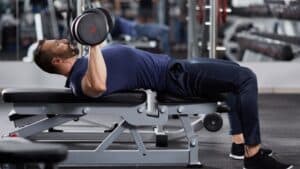Are you ready to take your chest workout to the next level? This comprehensive guide is tailored for fitness enthusiasts looking to enhance their upper body strength and sculpt a chiseled chest. Whether you’re a gym veteran or just starting out, this workout program offers exercises that challenge your muscles while promoting proper form and technique. With a focus on maximizing gains, you’ll learn how to target every part of your chest effectively, ensuring balanced development and strength. Plus, the flexibility of dumbbell training allows you to perform these exercises anywhere, making it easier than ever to fit a killer workout into your busy routine. Get ready to push your limits and unlock your true potential, as we dive into a dynamic and effective dumbbell chest workout with dumbbells that will have you feeling stronger and more confident in no time!
Benefits of Dumbbell Training for Chest Muscles
Dumbbell training offers numerous advantages for chest muscle development, primarily due to the range of motion it facilitates. Unlike barbells, which can limit movement patterns, dumbbells allow for a more natural and extensive range of motion. This enhanced flexibility ensures that the pectoral muscles are engaged more effectively, leading to better muscle activation and growth. Moreover, the independent movement of each arm with dumbbells helps to address muscular imbalances, ensuring both sides of the chest develop evenly and symmetrically.
Another significant benefit of dumbbell training is the increased activation of stabilizer muscles. When using dumbbells, your body must engage various stabilizing muscles to maintain balance and control throughout the exercise. This additional muscle engagement not only contributes to a more comprehensive workout but also helps to improve overall muscular coordination and functional strength. By incorporating these stabilizer muscles, dumbbell exercises can enhance your overall athletic performance and reduce the risk of injuries.
Additionally, dumbbells offer unparalleled versatility in your workout routine. They can be used to perform a wide range of exercises targeting different parts of the chest, including the upper, middle, and lower regions. This versatility allows you to customize your workouts to meet specific goals and preferences, ensuring that you can continually challenge your muscles and promote consistent growth. Furthermore, dumbbells are accessible and convenient, making it easy to perform effective chest workouts whether you’re at the gym, at home, or on the go.
Essential Dumbbell Exercises for Chest Development
To achieve maximum gains in chest development, it’s crucial to incorporate a variety of essential dumbbell exercises into your workout routine. These exercises will target different areas of the chest, ensuring comprehensive muscle engagement and growth. One of the most effective exercises is the dumbbell bench press, which primarily targets the middle chest. By lying on a flat bench and pressing the dumbbells upwards, you can stimulate significant muscle activation in the pectoral region.
Another key exercise is the dumbbell fly, which focuses on stretching and contracting the chest muscles. This exercise involves lying on a flat bench, holding dumbbells above your chest with a slight bend in your elbows, and slowly lowering them to the sides before bringing them back together. The dumbbell fly is excellent for enhancing the width and definition of the chest, providing a deep stretch that promotes muscle growth and flexibility.
Incline and decline dumbbell presses are also essential for targeting the upper and lower portions of the chest, respectively. By adjusting the angle of the bench, you can shift the emphasis to different areas of the pectoral muscles. Incline presses, performed on a bench set at a 30 to 45-degree angle, focus on the upper chest, while decline presses, done on a bench set at a negative angle, target the lower chest. These variations ensure balanced development across the entire chest, contributing to a more well-rounded and aesthetically pleasing physique.
Structuring Your Dumbbell Chest Workout Routine
Creating an effective dumbbell chest workout routine requires careful planning and consideration of various factors, including exercise selection, volume, and intensity. To start, it’s essential to choose a variety of exercises that target different areas of the chest. This ensures comprehensive muscle engagement and prevents overemphasis on any single region. A well-rounded routine might include exercises such as the flat bench press, incline press, decline press, and dumbbell fly.
When structuring your workout, it’s crucial to consider the volume of your training the total number of sets and repetitions performed. For optimal muscle growth, aim for a moderate to high volume, typically around 3-4 sets of 8-12 repetitions per exercise. This rep range is known for promoting hypertrophy, the process of muscle growth. Additionally, ensure you incorporate sufficient rest between sets, usually around 60-90 seconds, to allow your muscles to recover while maintaining intensity.
Intensity is another key factor in designing your dumbbell chest workout. To maximize gains, it’s important to progressively overload your muscles by gradually increasing the weight of the dumbbells or the difficulty of the exercises. This progressive overload stimulates muscle adaptation and growth over time. Additionally, incorporating advanced techniques such as drop sets, supersets, and tempo variations can further enhance the effectiveness of your workout, challenging your muscles in new ways and preventing plateaus.
Tips for Proper Form and Technique
Maintaining proper form and technique during dumbbell chest exercises is crucial for maximizing gains and minimizing the risk of injury. One of the fundamental principles of proper form is ensuring a stable and controlled movement throughout each exercise. This means avoiding excessive swinging or bouncing of the weights and focusing on a slow and controlled tempo. By controlling the movement, you can engage the target muscles more effectively and reduce the strain on your joints and connective tissues.
Another important aspect of proper technique is maintaining a neutral spine and a stable core during exercises like the dumbbell bench press or fly. This involves keeping your back flat against the bench, avoiding excessive arching or rounding of the lower back, and engaging your core muscles to provide stability. Proper alignment not only enhances muscle activation but also protects your lower back and shoulders from unnecessary strain.
Additionally, it’s essential to pay attention to your breathing patterns during dumbbell chest exercises. Generally, you should exhale during the exertion phase of the exercise (e.g., pressing the dumbbells up) and inhale during the lowering phase. Proper breathing helps to stabilize your core, maintain focus, and provide the necessary oxygen to your working muscles. By combining controlled movements, proper alignment, and effective breathing, you can ensure that your workouts are both safe and effective.
Common Mistakes to Avoid During Dumbbell Chest Workouts
While dumbbell chest workouts can be highly effective, there are several common mistakes that can hinder your progress and increase the risk of injury. One of the most frequent errors is using excessive weight at the expense of proper form. Lifting too heavy can lead to compromised technique, reduced range of motion, and increased risk of injury. It’s important to choose a weight that allows you to perform each exercise with correct form and full range of motion, gradually increasing the weight as your strength improves.
Another common mistake is neglecting to warm up properly before starting your chest workout. A thorough warm-up is essential for preparing your muscles, joints, and cardiovascular system for the demands of the workout. Incorporate dynamic stretches, light cardio, and mobility exercises to increase blood flow to the chest muscles and enhance their flexibility. Skipping the warm-up can lead to muscle strains and decreased performance during your workout.
Additionally, many individuals tend to rush through their exercises without paying attention to the quality of each repetition. Performing exercises too quickly or with jerky movements can reduce muscle engagement and increase the risk of injury. Focus on maintaining a controlled tempo, emphasizing both the concentric (lifting) and eccentric (lowering) phases of each exercise. This will ensure that your muscles are fully engaged and working to their maximum potential.
Incorporating Dumbbells into a Full-Body Workout
Incorporating dumbbells into a full-body workout can provide a balanced and effective training regimen that enhances overall strength and muscle development. Dumbbells offer versatility and can be used to target various muscle groups beyond the chest, allowing for a comprehensive full-body workout. By including exercises for the legs, back, shoulders, and arms, you can create a well-rounded routine that promotes overall fitness and functional strength.
For instance, combining chest exercises like the dumbbell bench press with lower body movements such as dumbbell squats or lunges can create a balanced workout that challenges multiple muscle groups. Additionally, incorporating dumbbell rows and shoulder presses can target the back and shoulders, ensuring a full-body training session. This approach not only maximizes muscle engagement but also promotes better coordination and functional movement patterns.
Furthermore, integrating dumbbell exercises into a full-body workout allows for greater flexibility in your training schedule. By targeting multiple muscle groups in a single session, you can reduce the frequency of your workouts while still achieving significant results. This is particularly beneficial for individuals with busy schedules who may find it challenging to dedicate time to separate muscle group workouts. A well-structured full-body routine with dumbbells can provide an efficient and effective way to achieve your fitness goals.
Nutrition Tips for Maximizing Chest Gains
Proper nutrition plays a critical role in maximizing chest gains and overall muscle development. To support muscle growth, it’s essential to consume an adequate amount of protein, which provides the building blocks for muscle repair and growth. Aim for a protein intake of around 1.6 to 2.2 grams per kilogram of body weight per day, incorporating sources such as lean meats, fish, eggs, dairy products, legumes, and protein supplements.
In addition to protein, carbohydrates are crucial for providing the energy needed to fuel your workouts and support recovery. Complex carbohydrates, such as whole grains, fruits, and vegetables, should form the basis of your diet. These sources provide sustained energy and essential nutrients that aid in muscle repair and growth. Consuming carbohydrates before and after your workouts can help optimize performance and enhance recovery.
Healthy fats are also important for supporting hormone production and overall health. Include sources of unsaturated fats, such as avocados, nuts, seeds, and olive oil, in your diet. These fats provide essential fatty acids that play a role in muscle recovery and inflammation reduction. Additionally, staying hydrated is vital for optimal muscle function and recovery. Aim to drink plenty of water throughout the day, especially before, during, and after your workouts.
Progress Tracking and Adjustments
Tracking your progress and making necessary adjustments are key components of a successful dumbbell chest workout program. Regularly monitoring your performance allows you to assess your strengths, identify areas for improvement, and make data-driven decisions to optimize your training routine. One effective way to track progress is by keeping a workout journal, recording details such as the exercises performed, weights used, sets, reps, and any notes on form or difficulty.
In addition to tracking your workouts, regularly assessing your physical measurements and body composition can provide valuable insights into your progress. Measurements such as chest circumference, body weight, and body fat percentage can help you gauge the effectiveness of your training and nutrition plan. Progress photos taken at regular intervals can also be a powerful visual tool to track changes in your physique over time.
As you track your progress, be prepared to make adjustments to your workout routine and nutrition plan as needed. This may involve increasing the weight of your dumbbells, incorporating new exercises to target different muscle fibers, or adjusting your caloric intake to support muscle growth or fat loss goals. By staying adaptable and responsive to your progress, you can ensure that your training remains effective and aligned with your fitness objectives.
Conclusion
Embarking on a journey to unleash your strength and achieve maximum gains with a dumbbell chest workout is an exciting and rewarding endeavor. By incorporating the essential exercises, maintaining proper form, and avoiding common mistakes, you can optimize your training and promote significant muscle growth. Additionally, integrating dumbbell exercises into a full-body workout and following proper nutrition guidelines will support your overall fitness and enhance your results.
As you progress, remember the importance of tracking your performance and making necessary adjustments to continually challenge your muscles and prevent plateaus. Stay committed to your goals, and be patient with the process, as consistent effort and dedication are key to achieving long-term success. Whether you’re a seasoned gym-goer or just starting out, this comprehensive guide provides the tools and knowledge needed to elevate your chest workouts and achieve your fitness aspirations.
Now, it’s time to take action and implement the strategies outlined in this guide. Set clear goals, create a structured workout plan, and stay disciplined in your training and nutrition. With determination and perseverance, you’ll be well on your way to unlocking your true potential and achieving the chiseled, powerful chest you’ve always desired. So grab those dumbbells, push your limits, and embark on the path to becoming stronger, more confident, and empowered in your fitness journey.






